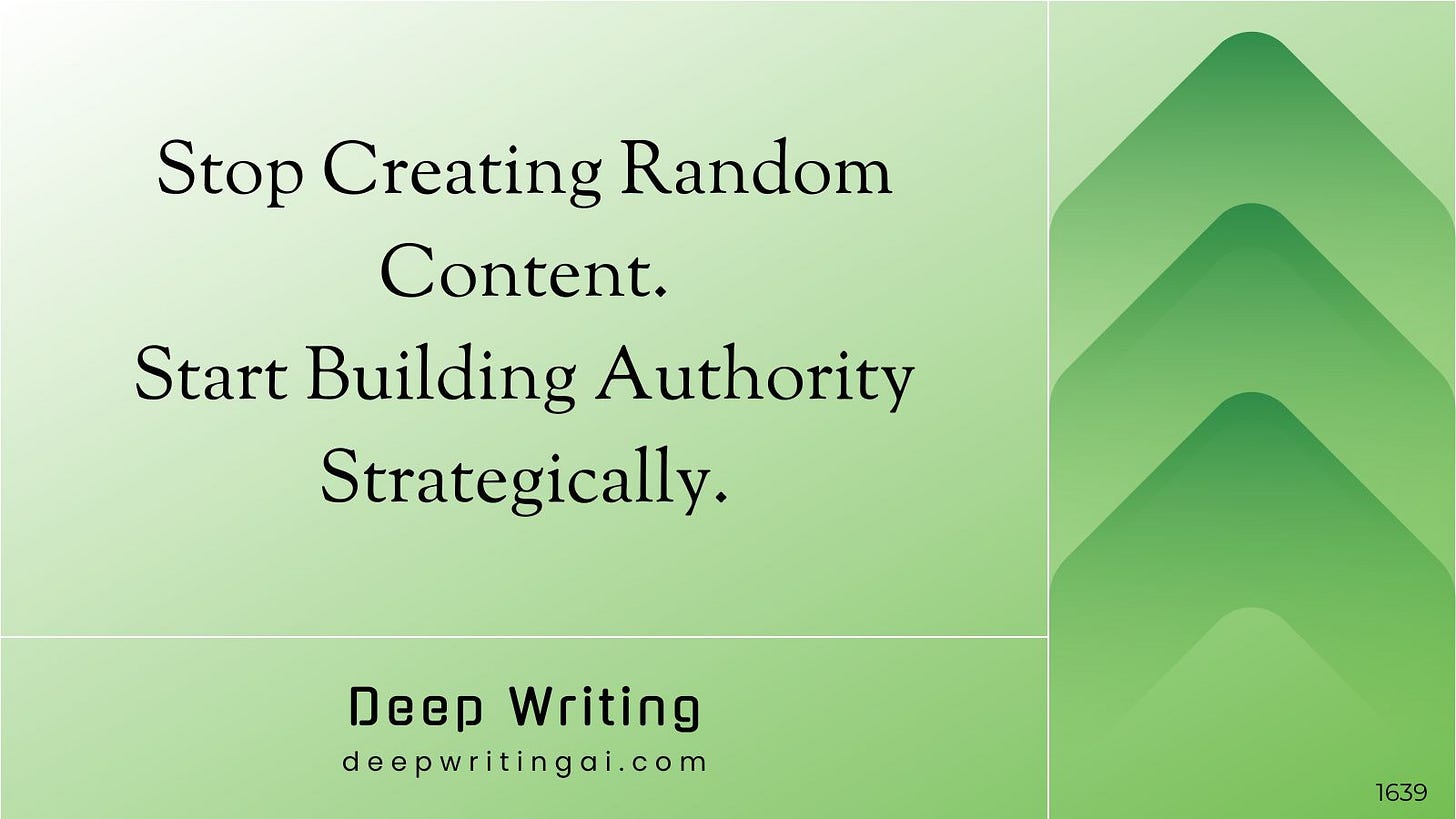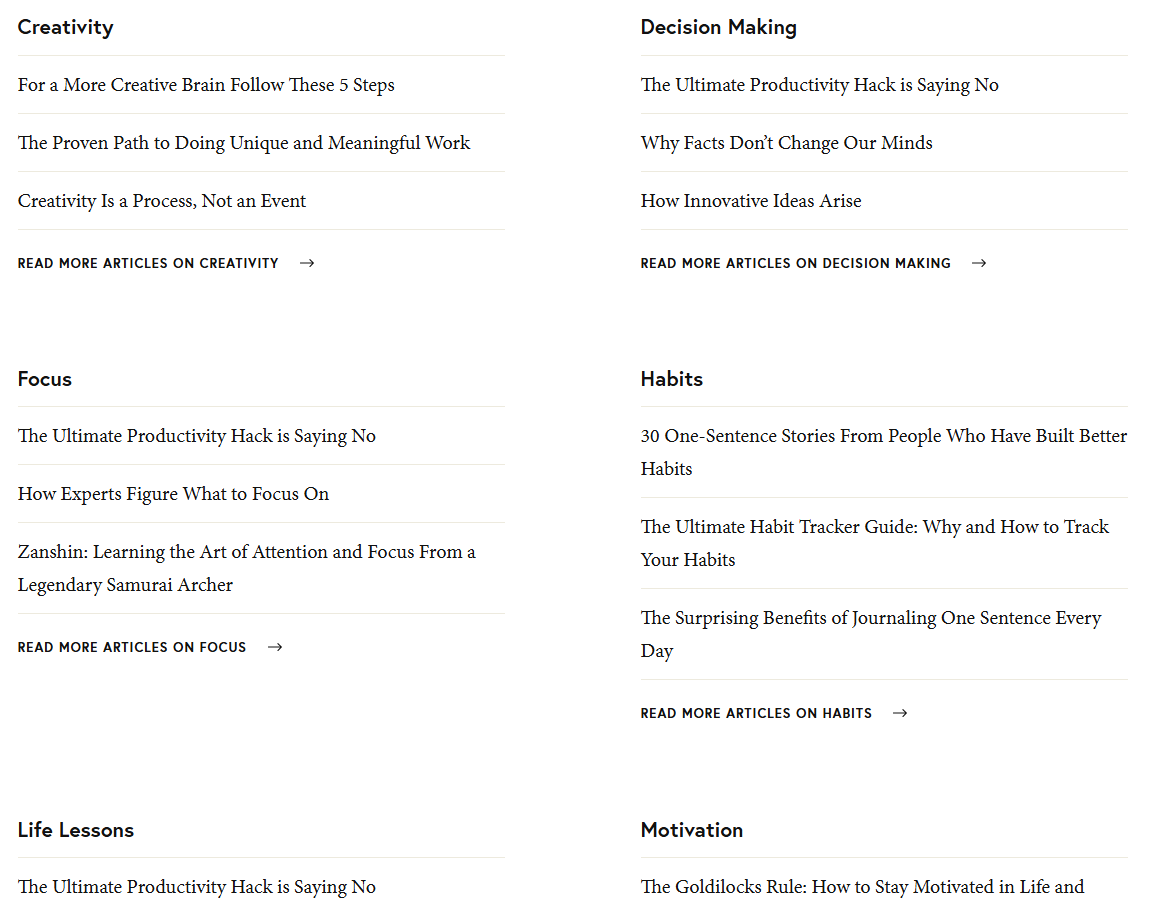The Beginner's Strategy for Building Authority Online
... and commanding premium prices
The old way of selling online is dead.
Bombarding people with ads and hoping something sticks is an expensive game.
The new path to revenue isn’t shouting louder than your competition. It’s establishing genuine authority in your niche.
And the simplest way to establish authority online is to become the informational source for your ideal customer.
When you create a body of content that proactively solves the pain points your ideal customer has, or teaches them something that makes their lives better, they feel connected and are much more likely to respond to your offer.
This is exactly how HubSpot stood out in a highly saturated and competitive SaaS market — by creating high-quality, in-depth content.
And once you establish yourself as the go-to authority in your niche, everything in your business becomes easier.
You no longer chase clients. They seek you out.
Your sales conversations shift from convincing people of your value to discussing how you’ll work together.
You can charge premium prices because the ideal customer already recognizes your expertise.
Every entrepreneur worth their salt knows this.
They start creating content with lots of enthusiasm, with the goal of becoming an authority in their niche.
Yet most of them never get there. Why?
99% of online creators are reactive
They chase trends, react to random ideas, and write about whatever inspires them that week.
I call them content hamsters, forever running on the hamster wheel of reactive creation, starting from zero each time thinking “What should I write about this week?”
As a result, their content feels scattered, their audience feels confused, and they can’t point to a clear territory they own.
Six months on, they’re frustrated. The growth plateaus despite working twice as hard, until they eventually burn out and quit.
The fact is, they make content creation a lot harder than it needs to be.
Only 1% of creators online create with intention and strategy
I call them authority builders.
What I’ve learned studying successful creators is that authority isn’t just about creating good content.
It’s about systematically covering a territory.
Hang on a sec, it’ll become clear.
Authority builders understand that each piece of content serves a specific purpose.
They might publish less frequently, but everything they create strategically builds their position as the go-to expert.
Their content forms a cohesive body of work that naturally leads prospects toward their offers.
They work from systems, not inspiration.
Marking your territory, or as the geeks call it: “identifying your topic taxonomy“
Think about someone you consider an authority in their field.
Go through their content carefully, and you’d see they organize their content into 4-5 broad themes.
These are the things they wish to be known for, also known as content pillars.
Take Justin Welsh, one of the most authoritative voices on solopreneurship as an example.
His content is strategically organized around six pillars:
Personal Growth
Business Planning
Personal Branding
Social Media Growth
Monetizing Knowledge
Productivity & Time Management
Similarly, James Clear divides his content into 8 authority pillars:
Creativity
Decision Making
Focus
Habits
Life Lessons
Motivation
Productivity
Self Improvement
Once these top creators identify the major themes, they define 5-10 specific topics under each pillar that their ideal customers genuinely care about.
These are more specific, and often address particular pain points or aspirations.
For example, Justin’s “Business Planning” can be broadly classified into these sub-pillars:
Finding a profitable niche
Crafting a business roadmap
Becoming a solopreneur
Solopreneur business models
Defining your mission and goals
This carefully mapped territory (topic taxonomy) covers everything his ideal audience needs to know about building a successful one-person business.
Each piece of content he publishes strengthens his claim on this territory.
When someone discovers his work through a LinkedIn post about “finding your profitable niche,” they naturally discover his other content about business planning, social media growth, and monetization.
The result?
Justin is now recognized as one of the definitive authorities on building a solopreneur business online, making millions in digital product sales, all without spending a dime on paid advertising.
Now that you know what topic taxonomy is, and why it’s important, let’s see how to create yours using AI.
How to create topic taxonomy using AI
This prompt works best with Deep Research models like ChatGPT’s Deep Research and Gemini Deep Research.
Open up a new research window and paste the below prompt:
<Role>:
You are an expert market researcher tasked with generating a carefully structured topic taxonomy specifically tailored to my brand. The goal is to establish myself as the go-to authority in my niche by creating strategic, connected content that positions me as the definitive resource for my ideal customers.
I will provide the following detailed brand documents for your analysis:
1. Unique Value Proposition (UVP)
2. Ideal Reader Persona (audience demographics, behaviors, goals, interests)
3. Key Pain Points faced by the Ideal Reader
<Task>:
Your goal is to deeply research, analyze, and propose a comprehensive topic taxonomy to guide content ideation and ensure alignment with the brand’s UVP and the ideal audience’s needs and pain points.
Structure your taxonomy clearly as follows:
Level 1 (Pillar): Identify 4-6 primary pillars that directly align with the brand’s UVP and strongly address the audience’s pain points.
These should be broad enough to encompass multiple sub-topics but specific enough to claim a distinct territory.
Provide a brief rationale explicitly connecting each pillar to the brand’s UVP and the ideal reader's identified pain points.
Level 2 (Sub-pillars/Clusters): Under each pillar, propose 5-10 focused sub-pillars or clusters.
These should address specific pain points, questions, or aspirations my audience has.
For each sub-pillar, include a concise rationale that clearly links it to both its parent pillar and audience pain points.
Level 3 (Specific Topics/Questions): Within each sub-pillar, list 3-5 specific, actionable, and engaging topics or questions that resonate with the ideal audience and address their specific concerns or interests.
<Important Guidelines>:
* Your output must be based entirely on the provided brand documents.
* Clearly state your rationale for each level, linking explicitly back to the UVP and audience pain points.
* If the provided documentation is unclear or insufficient for confident taxonomy generation, explicitly state any uncertainties and request additional clarifications from the user rather than guessing.
<Output Format>:
Present your findings strictly in the following structured format:
Level 1 – Pillar #1: [Name of Pillar]
- Rationale (briefly connect pillar to UVP & pain points)
- Level 2 – Sub-pillar #1:
- Rationale (connection to Pillar & audience pain points)
- Level 3: Specific topics/questions:
1. [Specific topic/question]
2. [Specific topic/question]
3. [Specific topic/question]
- Level 2 – Sub-pillar #2:
- Rationale
- Level 3: Specific topics/questions:
1. ...
2. ...
3. ...
(Continue clearly through all pillars)
<UVP>:
[Paste your UVP here]
<Ideal Reader Persona>:
[Paste your ideal reader persona here]
<Key Pain Points>:
[Paste your ideal reader's pain points here]
#####
Please begin by thoroughly analyzing the provided documents and request clarification immediately if you encounter insufficient detail or ambiguity to ensure maximum accuracy and relevance of your taxonomy proposal.Paste your UVP, Ideal reader persona, and their pain points at the designated places.
Check this article in case you need help creating any of the above.
Answer any follow-up questions the model asks and wait for the results.
Here’s a pillar it generated for a hypothetical business that sells turmeric-based health drink:
The pillars are broad and evergreen, and each has a few specific sub-themes.
For instance, under Lifestyle & Recipes, sub-topics like “pre-workout mocktails” or “golden-milk lattes” indicate recurring content ideas (perhaps a series of recipe posts or lifestyle tips centred on those themes).
Notice how each sub-theme is narrow enough to be interesting, but not so narrow that you’d run out of content ideas.
Pretty solid!
How to use your territory map to build authority
Store your taxonomy in a document and use it in your next ideation session.
The question is no longer “What should I write about this week?”
You simply look at the map and ask “Which part of my territory needs strengthening right now?”
Do not just ask the AI to produce article ideas. Specify the pillar and subpillar you’d want to create content around.
The aim is to produce enough content under each pillar that someone exploring your site could get a full education on that theme.
When creating content, use your taxonomy to create meta tags and on-page SEO. Include pillar keywords in category pages, and sub-topic keywords in titles and headings.
Iterate
Remember, this taxonomy is just the first draft. Over time, you may need to tweak your taxonomy. Maybe one pillar isn’t performing or you discover a new pillar emerging from audience feedback.
Schedule periodic check-ins to evaluate if your taxonomy still reflects your content and audience interests. If you pivot your business, the taxonomy should pivot with you.
From scattered content to genuine authority
Here’s what happens when you implement a strategic topic taxonomy:
Your content creation becomes effortless. No more wondering what to write about. Your map guides you.
Your audience starts recognizing patterns in your content. They begin to associate you with specific expertise territories and return to you for more information.
Search engines start trusting your site on certain topics. When a website covers a subject in great detail through many interrelated pieces, Google starts viewing it as an authority on that subject.
You transform from just another content creator into a recognized authority, someone whose opinion matters, whose expertise is valued, and whose offers command premium prices.
So ask yourself: Are you still running on the content hamster wheel, or are you ready to start building with intention?







This is great! Thank you!
I generated a version with Deep Research in Gemini 2.5, Perplexity, and ChatGPT o3.
Now I'm putting them into NotebookLM and using the mind map feature to explore further!
As a career and personal development coach with 30+ years of cross-industry experience — ranging from digital marketing and leadership development to branding and emotional intelligence — I found this article both insightful and timely. I’m currently working on content strategies for professionals across different career stages (recent grads to CXOs) and startup founders, and the idea of AI-powered content mapping resonates deeply with my efforts to create tailored, high-impact messaging.
I particularly appreciate the focus on building authority by aligning content with core themes and transformation goals. That said, I’m curious to hear your thoughts on a few related areas:
Audience Segmentation: How do you recommend using AI tools to differentiate content strategies for varied audience segments, such as Gen Z job seekers and senior professionals vs. entrepreneurs?
Persona Development: Do you have preferred frameworks or AI prompts that help refine detailed personas beyond the usual demographic and behavioral traits?
Pain Points by Segment: What methods or tools do you suggest for mapping pain points specific to each audience persona in a way that feeds directly into a content map?
I’d love to see a follow-up or deeper dive into how AI can be used not just for content generation, but for dynamic audience analysis and message alignment over time.
Thanks for a great read!